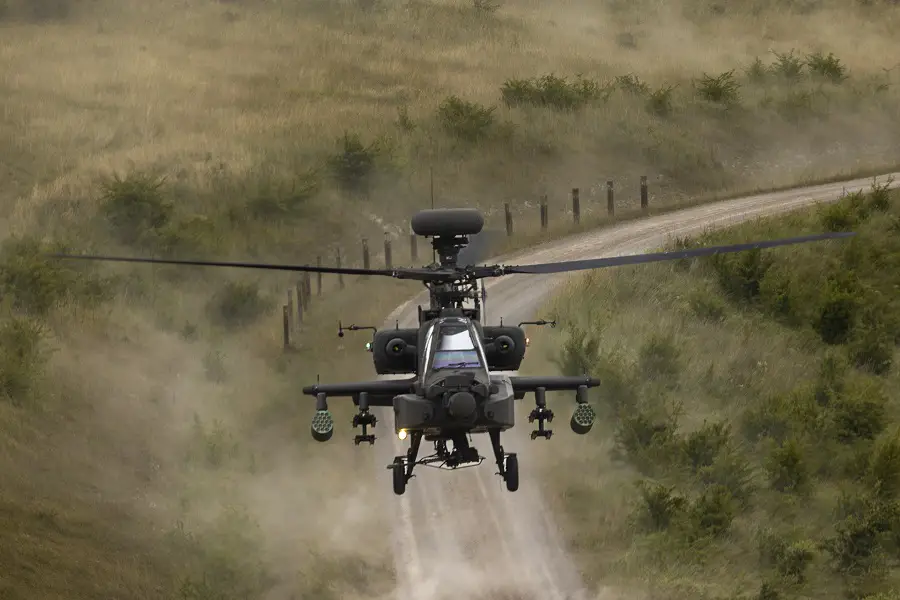The home of Army Aviation, Middle Wallop, is now operating the British Army’s latest addition to its aircraft inventory, the jaw dropping Apache AH-64E. The Apache attack helicopter has been in service with the British Army for some twenty-two years during which it has proven itself an invaluable asset in support of operations in Afghanistan, Libya, and worldwide. However, that was the Apache D variant, or as it was designated by the British, the Apache Mk1. The latest Apaches, the AH-64Es, mark a leap in attack helicopter performance. It’s faster and can climb quicker thanks to its new composite rotors, designed to withstand hits from anti-aircraft guns; they also allow it to carry a heavier payload of weaponry and thus increase its lethality. Those weapons will have their targets acquired and guided by a vastly improved radar and sighting systems suite that will have the ability to integrate with remotely piloted air systems (RPAS or “drones”). The aircraft also includes an advanced target prioritising system which helps with rapid reassessment and survivability in countering enemy threats.
During the introduction of the AH-64E the Defence Science and Technology Laboratory provided analysis of the human machine interface that identified potential risks to aircrew as they converted to flying the new helicopter. Whilst Wattisham Airfield is home to the front line AH-64E regiments, these new AH-64E helicopters stationed at Middle Wallop will be operating with 7 Regiment Army Air Corps as the instructional platforms on which the pilots and gunners of tomorrow will train to become the most feared and lethal combination on the battlefield. The UK Government has placed an order for 50 of these fearsome attack helicopters with its manufacturer, the United States Boeing Corporation. The purchase and introduction of these cutting-edge aircraft is a significant element of the Army’s modernisation focusing on the deep fight as part of the Future Soldier programme. The AH-64E is a highly potent fighting component of the Army’s ‘Future Force 2025’, the date by which all 50 airframes should be in service.

The step change brought about by the procurement of these attack aircraft has been matched by a transformation in the criteria for those who aspire to fly them. Once only the preserve of Non-Commissioned Officers and Officers, applications to train to be an Army Air Corps Pilot have now been expanded to include Private soldiers and equivalent ranks with a recommendation for promotion. It means that soldiers in the infancy of their military careers and from any regiment or corps across the Army can apply for flying training. It opens up a much larger talent pool that will benefit the Air Corps greatly. As you would expect the training path towards the first flight in an Apache AH-64E is long, and challenging with only the best of the best making it through to climb aboard. It starts with Phase 1 which is the selection process held at Royal Air Force (RAF) Cranwell. Here the prospective pilots are put through a medical board and their physical suitability assessed for aircrew selection. During this phase they also undertake various aptitude tests to ensure their eye, feet and hand co-ordination is at the desired level and their mental dexterity assessed. Those who make it will then proceed to Flying Grading.
Candidates get their hands on an aircraft’s controls for the first time as they complete 13 hours in a fixed wing training aircraft over a three-four week period; this phase ends with an interview by the Pilot Selection Board at the Corps’ Headquarters in Middle Wallop. Fail at this point and it is the end to your flying aspirations as you are not able to reapply. Those who get through move on to the Army Pilot’s Course. Then comes the introduction to helicopters, the basic rotary wing training is conducted at the Defence Helicopter Training School at RAF Shawbury. Here the trainee pilots take to the Juno training helicopter before moving on to the advanced rotary wing phase, learning to fly low level, in formation and at night. This also includes advanced procedural instrument flying. The pilots progress to take up their operational training; this is the conversion from basic pilot to an Army pilot, training them to operate in a battlefield environment including time being tested in a tactical simulator. It is at this point that those destined to fly the AH-64E climb into the cockpit of the spectacular aircraft and can truly call themselves an Apache pilot.
















